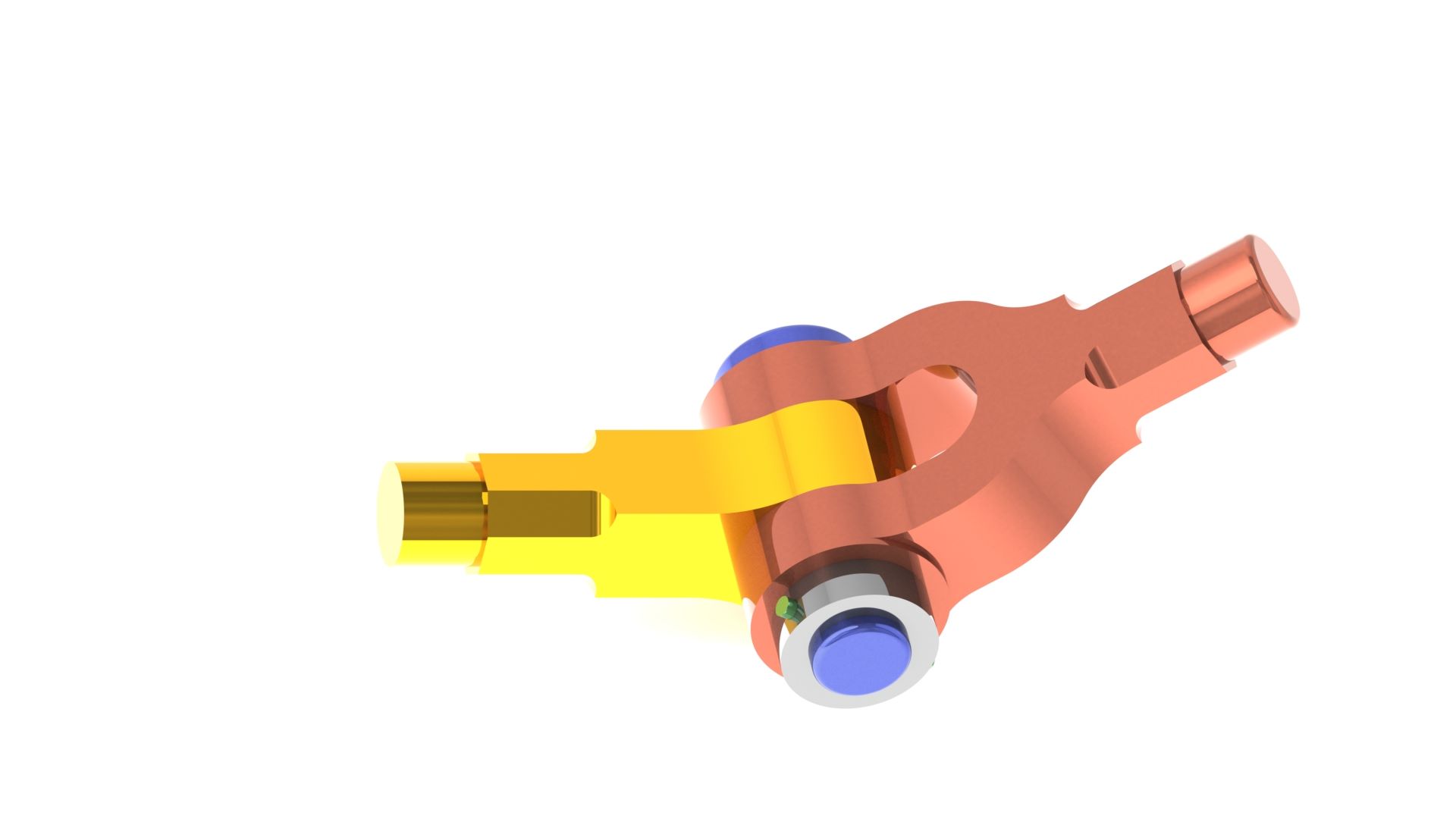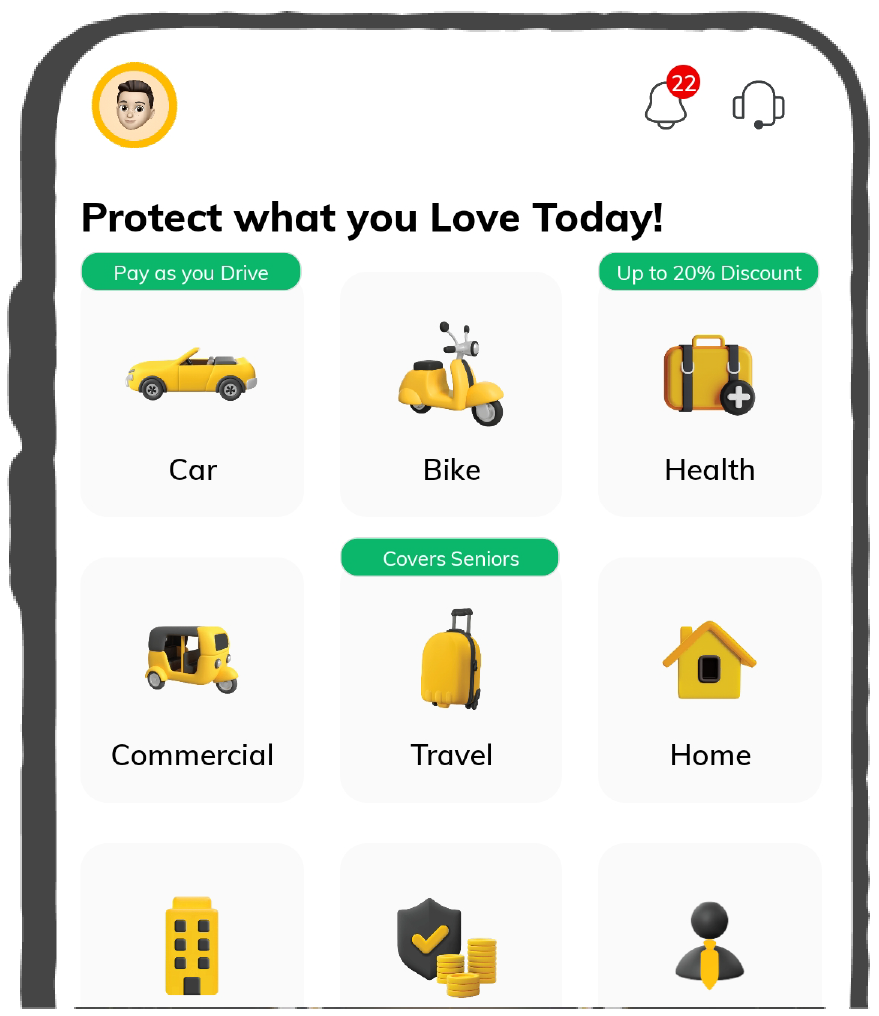What is a Knuckle Joint in Cars?

A knuckle joint is a mechanical device that connects two components under tensile loads. It is also known as a forked pin joint. A common example of a knuckle joint is the connection between a tractor and a trolley. The knuckle joint allows for a small amount of flexibility or angular movement between the tractor and the trolley.
Keep scrolling to learn about this mechanism in detail.
Definition of Knuckle Joint
A knuckle joint connects two rods or bars at an angle, which lets them rotate with limited angular movement. It comprises a pin or rod inserted into a series of alternating holes in two components, enabling rotation and axial movement. People commonly use knuckle joints in applications requiring flexibility and articulation, such as linkages and suspension systems.
Knuckle Joint Assembly
A knuckle part or assembly is as follows:
Single Eye End
A single-eye end is one of the two main components of a knuckle joint. It is a cylindrical rod with a single hole drilled through it, located near one end of the rod. The other end of the rod has a fork-like shape with two holes drilled through it.
The single eye end is inserted into the fork end of another rod, and a pin is passed through all three holes to secure the joint.
Double Eye End or Fork End
A double-eye end, also called fork end, is a joint used to connect two rods loaded under tensile load. The double-eye end has two holes on either side, forming a fork-like shape. The single-eye end is inserted between the double eyes so that all three holes are centred.
A pin is then inserted through holes to secure the joint. Double-eye or fork ends are commonly used in tie rods, tension links, and bridges.
They are also used in other applications where two rods must be connected and secured under tensile load. The fork-like shape of a double-eye end prevents the joint from opening under load.
Two Rods
Two rods are connected by a pivot, which allows them to rotate around each other. Pivot is typically made of strong material, such as steel, to ensure that it can withstand the forces applied to it. The rods are also typically made of strong materials, such as steel or aluminium, to ensure they can withstand the forces applied to them.
Knuckle Pin
A knuckle pin is a cylindrical rod with a head at one end and a threaded hole at the other. It is used to connect two pipes or rods in an angular manner. It allows limited angular movement between them.
The diameter of a pin is calculated based on the load it will be subjected to. A Pin is inserted through the holes in two rods and secured with a taper pin or cotter pin.
Collar
In a knuckle joint, the collar is located at the centre of the joint and is used to hold two shafts in place. A collar is typically made of strong material, such as steel or brass, and is designed to withstand the forces applied to the joint.
The collar is also designed to allow limited movement between the two shafts, which enables the joint to function properly. Without the collar, two shafts would not be able to stay in place, and the joint would not be able to function.
Tape Pin or Lock Pin or Split Pin
A tape pin is a type of pin used to connect two parts of a knuckle joint. It is made of a thin, flexible metal strip, usually stainless steel, wrapped around the joint parts and then secured in place.
Tape pins allow for limited angular movement and rotation between the joint parts while still providing a secure connection.
Construction of Knuckle Joint
Check out the construction procedure of a knuckle joint:
The knuckle joint establishes a connection between two rods, with one rod featuring a single-eye end and the other having a double-eye end or fork end.
Single-eye end refers to the end with one hole, while the double-eye end refers to the end with two holes.
The single-eye end is positioned between the double eyes of the double-eye end or fork end.
Subsequently, a knuckle pin is inserted into the holes of the eye and fork ends, securing them together.
A section of the knuckle pin extends outward from the lower hole of the fork end, and a small hole is present near the bottom of the knuckle pin.
A collar and a taper pin are employed to secure the knuckle pin in the eye and fork ends.
The collar possesses two holes, and it is aligned so that the hole in the knuckle pin aligns with the holes in the collar. Then, a taper pin is inserted through the collar's holes and the hole in the knuckle pin.
In this manner, a knuckle joint is formed.
Design Procedure of Knuckle Joint
The design procedure of a knuckle joint is as follows:
Selecting the appropriate material
When designing knuckle joints, the selection of materials holds significant importance. Various types of materials, particularly low-carbon steel, are ideal based on specific requirements.
Most manufacturers prefer aluminium for applications requiring a 50 KN load due to its favourable factor of safety (FOS). However, in advanced cases, ceramic materials can also withstand the stress developed in that specific zone.
Considering the properties of the chosen material
Choose C-30 as the material for all parts, considering the range of options available from C-15 to C-45.
Considering the factor of safety to ensure the joint can withstand anticipated loads
When designing any object, it is essential to consider the factor of safety. The safety factor represents the ratio of maximum stress to the working stress. A higher factor of safety reduces the likelihood of failure.
For instance, if the load is 50 KN, the design should be capable of withstanding a load of 60 to 70 KN or even higher.
Determining the permissible stress leve
Shear stress, maximum primary stress, and Imperial relation come under permissible stresses.
Designing the rods by taking dimensions and designs of parts into account
Measure the accurate dimensions and perform stress calculations for the knuckle joint. It experiences direct tensile stress, which you can calculate using the formula ς = P / π d2, where P represents the applied force. Additionally, the dimensions of the pinhead diameter and pinhead thickness should also be taken into consideration.
Material Used for Knuckle Joint
Manufacturers make knuckle joints using cast iron and stainless steel, with the option of using aluminium for lightweight applications. Furthermore, due to advancements in polymer technology, Teflon has emerged as an ideal material for knuckle joints.
A recent discovery revealed numerous advantages of using composite materials instead of cast iron for knuckle joints. These advantages include easy fabrication, enhanced safety, and environmental friendliness. The knuckle joint can be conveniently cast, fabricated, or forged.
Knuckle Joint Application
Various sectors widely utilise knuckle joints due to their versatility.
They play a crucial role in bridge construction, connecting the joint tension link and roof truss tie rod joint.
Knuckle joints are commonly useful in connecting rods for train wheels, facilitating the linkage between train coaches. They are also integral to the valve system of rotary engines.
These joints find applications in numerous areas, including cycling chains, roller chains, and watch chain straps.
Additionally, they are useful in the rod joint of jib cranes, lever pivots, tractor tire alignment components, and supporting the wheel assembly structure in cars.
Knuckle joints are also useful in downhole stringing for operations like flush eccentric work barrel stages, lateral drilling, re-entry into the well's bottom, and trawling.
Moreover, knuckle joints have widespread usage in robotic limbs, windshield wipers, and earthmoving equipment like cranes.
Knuckle Joint Advantages
Here are the advantages of a knuckle joint:
Knuckle joints possess the ability to withstand substantial tensile loads.
They exhibit excellent mechanical rigidity.
Furthermore, they offer simplicity in both manufacturing and installation processes.
One can effortlessly assemble and dismantle knuckle joints.
Their design is straightforward and uncomplicated.
With fewer components, they are cost-effective and reliable.
These joints enable rotational movement between two rods.
They maintain high repeating accuracy, even with varying material thicknesses and tensile strengths.
Knuckle joints minimise impact shocks and provide high system rigidity.
They also offer extended tool life.
Knuckle Joint Disadvantages
Along with many advantages, it has some disadvantages as well. These are:
A significant drawback is their inability to withstand large compressive loads.
One can perform angular movement in only one plane or axis using knuckle joints.
When compared to universal joints, knuckle joints offer less flexibility.
Knuckle Joint Failure
Designing knuckle joints to withstand tension without failure is crucial to prevent accidents.
The failure modes of knuckle joints include:
Shear failure of the knuckle pin (single shear)
Crushing of the pin against the rod
Tensile failure of the flat-end bar
Tensile failure of the solid rod
Bending of the knuckle pin
Tensile failure across the knuckle pin single eye or rod end hole
Shear failure of the single eye end beyond the knuckle pinhole (double shear)
Bending of a pin in the knuckle pinhole of the single-eye end
Tensile failure of the double eye end at the knuckle pinhole
Shear failure of the double eye end beyond the knuckle pinhole
Bearing failure of the pin in the knuckle pinhole of the double-eye end
These failure modes highlight the importance of carefully designing knuckle joints to ensure their reliability and prevent potential accidents.
In the following table, you will find the differences between a knuckle joint and a cotter joint:
|
Knuckle Joint |
Cotter Joint |
|
The knuckle joint links two rods that either coincide or intersect, lying in the same plane and experiencing axial tensile force transmission. |
The cotter joint joins two co-axial rods experiencing axial force. |
|
The knuckle joint efficiently handles high tensile loads. |
Cotter joints can withstand minor tensile and compressive forces. |
|
A knuckle joint can be useful when there is a requirement for angular displacement. |
A cotter joint is used when two rods have no angular displacement. |
|
Knuckle joints allow rods to move angularly. |
A cotter joint does not allow angular movement. |
|
No taper or clearance is available. |
Comes with clearance or taper. |
|
Fork end, rod end, and split pin are parts of knuckle joints. |
The three parts of a cotter joint are a cotter, a spigot, and a socket. |
|
A knuckle joint allows two shafts to move while maintaining a certain angle between them. |
The cotter joint helps aligned shafts rotate in the same direction. |
|
Bearing failure occurs pretty often. |
Bearing failure is not a common occurrence. |
|
Knuckle joint utilises a circular pin. |
Cotter joint utilises a rectangular pin. |
|
Tie bars, bicycle chain links, and all shifting mechanisms' joints use it. |
Cotter joint connects two rods with a pipe and attaches the piston rod to the crankshaft head in cotter foundation bolts. |


















